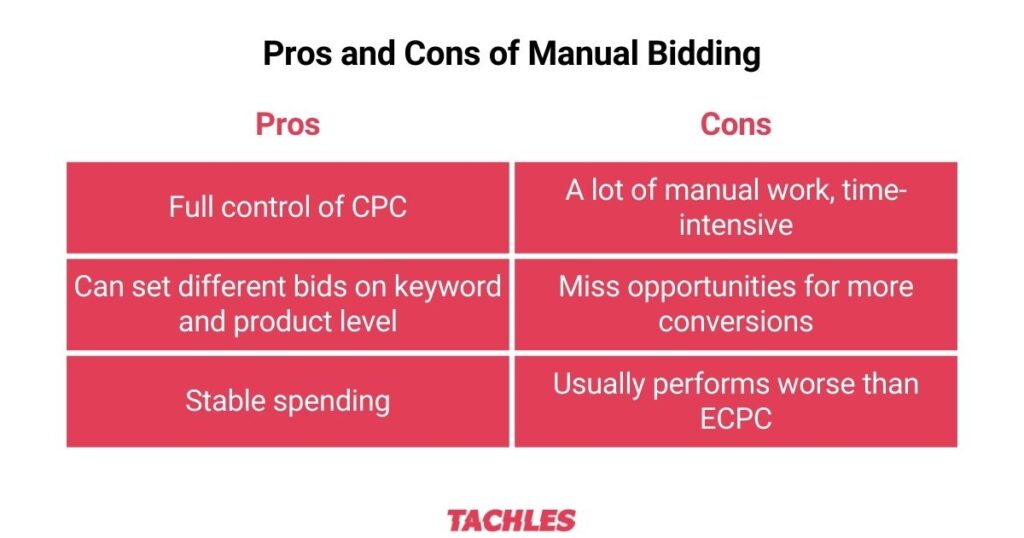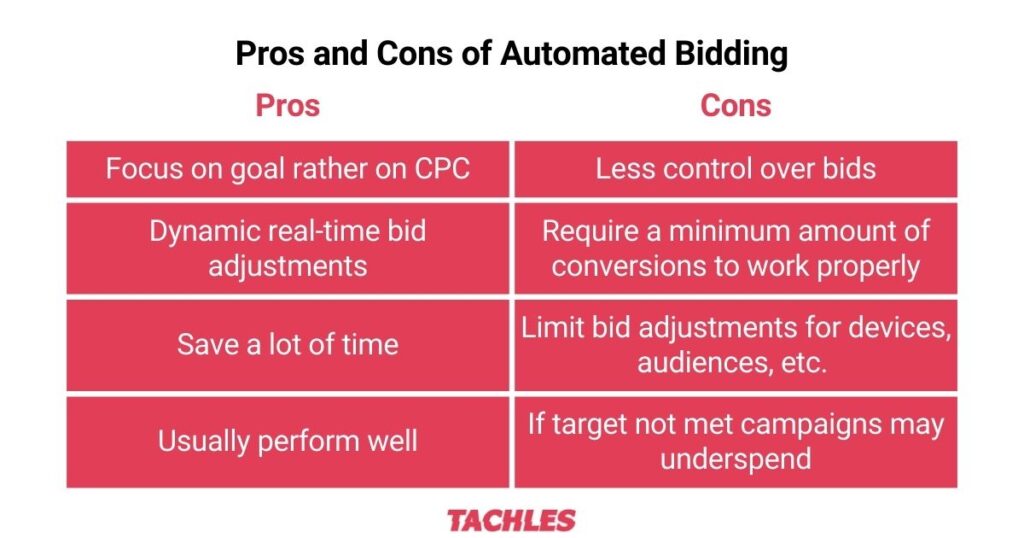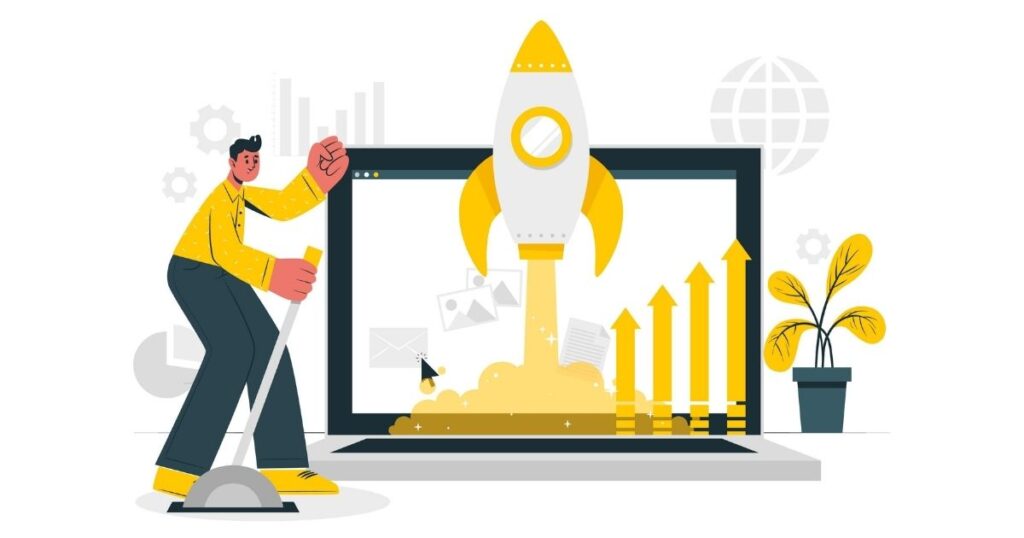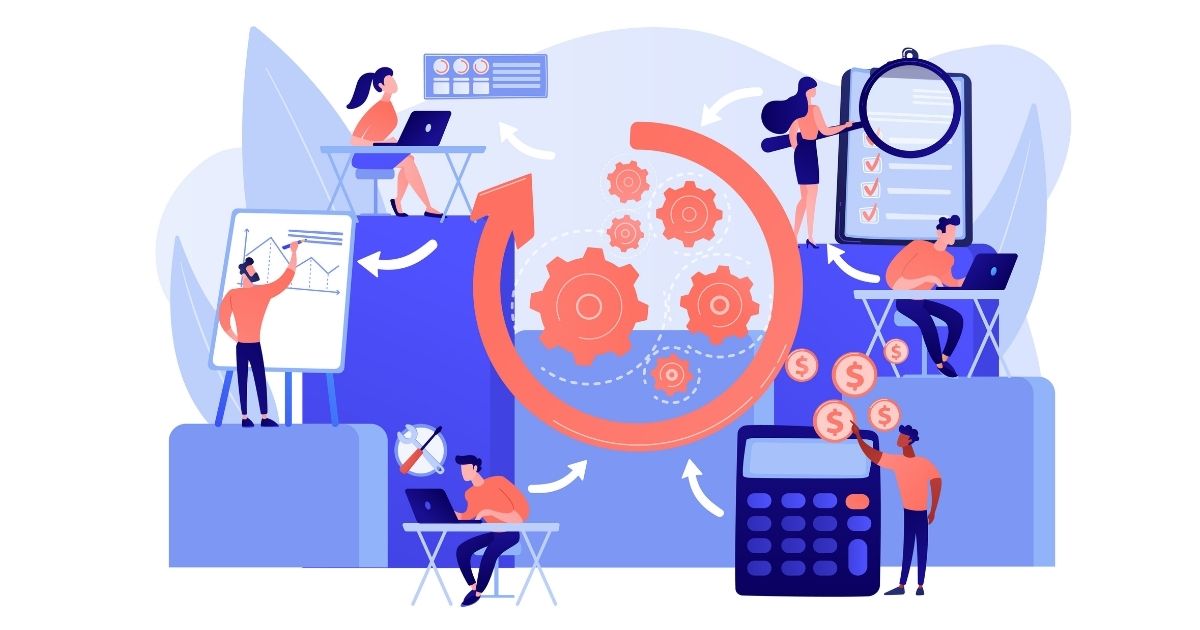Introduction
Selecting the right bidding strategy for your Google Ads campaign will have a big impact on your ads’ performance.
Choosing the right bid strategy can help you grow your business and win new customers. But if you choose the wrong one, you might be burning a lot of money and see little results.
In this article, we’ll explain the different types of bid strategies that are available on Google Ads, and how to select the right strategy for your Ecommerce campaigns.
- Introduction
- How Does Bidding Work in Google Ads?
- What Are Bidding Strategies in Google Ads?
- What Is the Difference Between Smart Bidding and Manual Bidding?
- Manual Bidding Strategy
- Automated Bidding Strategies
- How Do You Choose a Bidding Strategy?
- How To Select Bids in Google Ads?
- Regular Monitoring and Optimization
- Conclusion
- Further Reading:
- FAQs:
How Does Bidding Work in Google Ads?
Google Ads works (mostly) or a Pay-Per-Click (PPC) model. This means advertisers only have to pay when a potential customer clicks their ads.
Every time a user types a search term into Google, advertisers that bid on relevant keywords take part in an automated auction.
This auction takes into account multiple factors, such as:
- Relevance of the keyword the advertiser bid on the user’s search term
- Quality of the ad – does it seem relevant to the keyword?
- The bid – how much is the advertiser willing to pay for that click?
- Competition – how much are they willing to pay for it?
Each auction takes mere milliseconds. The ads with the best quality score and highest bids will win the auction and get more exposure. This means search or shopping ads will show at the top of the SERP (search engine results page), and display or YouTube ads will be shown in their appropriate placements.

What Are Bidding Strategies in Google Ads?
Google Ads Bid strategies are different logics advertisers can select for their campaigns, according to their business goals.
Each bid strategy puts a different objective in its focus. For example, advertisers who’d like to keep full control over their bids might use the manual CPC strategy, those who’d like to acquire as many customers as possible might use maximize conversions, and advertisers who’d like to keep a certain level of visibility among their competitors might use target impression share.
What Is the Difference Between Smart Bidding and Manual Bidding?
Manual bidding means advertisers set the max CPC for each keyword or product manually, and it is fixed. Smart bidding strategies use machine learning to automatically adapt the bid for each single auction, according to multiple signals, in order to meet the bid strategy’s goals.
The signals that affect the bidding include the keyword or product, the user (new or returning), their device, their browser, their location, seasonality, time of day, day of the week, and more.
Here’s a short review of each bid strategy.
Manual Bidding Strategy
This is the most basic bid strategy on Google Ads. Advertisers keep full control over their CPCs, on a keyword level.
Here are the pros and cons of manual bidding.
Advantages of Manual Bidding
- Full control of CPCs – you won’t pay more than you planned to.
- Full flexibility in bidding – advertisers can set different bids on the keyword or product level. For display and YouTube ads this will be on the ad group level.
- Stability of spend – advertisers can expect more or less stable daily spending.
Disadvantages of Manual Bidding
- A lot of manual work calculating and setting the bids for each keyword.
- Very time intensive as a result of all the manual work
- Bids might be under the ‘first-page bid’ and won’t trigger ads, due to bidding fluctuations from your competitors
- Missing opportunities to bid higher for users Google identifies as having a better potential to convert.
- Usually poorer performance compared to Enhanced CPC
As a whole, very few advertisers today use manual bidding.

Automated Bidding Strategies
In automated bid strategies, Google’s algorithm adjusts your bids in real-time according to multiple factors, to best meet your set objective. The algorithm is primarily guided by your main objective (e.g. maximize conversion value), and its value, if available (e.g. target ROAS 300%).
Your bids might be higher or lower for each user, device, location, keyword, etc., and are also affected by your actual performance.
Example:
If you set a target ROAS, or tROAS, of 300% for your shopping campaign and your actual performance over the past month was 400%, the bidding algorithm will set higher bids, in an attempt to get you more revenue.
If on the other hand, your campaign was only able to achieve an actual ROAS of 200%, the bidding algorithm will bid lower, until performance improves to meet tROAS 300%.
Types of Automated Bid Strategies
Automated bid strategies can be divided into two groups according to their main business objective.
Bid strategies that focus on conversion include:
- Enhanced CPC (ECPC)
- Maximize conversions
- Maximize conversions with a target CPA (target cost per action, or tCPA)
- Maximize conversion value
- Maximize conversion value with a target ROAS (target return on ad spend, or tROAS)
Bid strategies that focus on awareness and traffic include:
- Maximize clicks
- Target impression share
| Business objective | Bid strategy | When to use it |
|---|---|---|
| Conversions | Enhanced CPC (ECPC) | To get more conversions from manual bidding while keeping avg. CPC below the max CPC you set. |
| Conversions | Maximize conversions | To get as many conversions as possible within a fixed budget. |
| Target CPA (Target cost-per-action) | To get as many conversions as possible within a target cost-per-action goal. | |
| Conversion value (Revenue, Profit, Lifetime Value) | Maximize conversion value | To get as much conversion value as possible within a fixed budget. |
| Target ROAS (Target return on ad spend) | To get as much conversion value as possible within a target return on ad spend goal. | |
| Clicks/Traffic | Maximize clicks | To get the most clicks from your budget. |
| Awareness/Visibility | Target impression share | To show your ad on the absolute top of the page, on the top of the page, or anywhere on the page of Google search results. |
An additional bidding strategy, target CPM, focuses on maximizing reach and awareness. As it’s only available for Display and YouTube campaigns and our focus is online sales, we won’t discuss it anymore in this article. I’ll also ignore the awareness-focused smart strategies, as they are not so commonly used in Ecommerce accounts.
Let’s go over some of the pros and cons of automated bidding strategies.
Advantages of Automated Bid Strategies
- Focus on achieving a business goal rather than a fixed CPC
- Dynamic bid adjustments according to multiple factors
- Save a lot of time
- Usually perform well in line with targets
Disadvantages of Automated Bid Strategies
- Less control over bids
- Without a target, bids can be very high and not profitable
- Require a minimum amount of conversion data to work properly
- Can limit bid adjustments for devices, audiences or demographics (tROAS strategy ignores all bid adjustments except -100%)
- If the target isn’t achieved campaigns might underspend
- Less recommended for smaller budgets

How Do You Choose a Bidding Strategy?
There are 2 main things to consider when you choose a bidding strategy for a Google campaign:
- How many conversions does the campaign have?
- What is the business goal of this campaign?
Minimum Conversions for Automated Bid Strategies
Automated bidding strategies need a minimum amount of data in order to perform well. For a tCPA strategy, you’ll need at least 15 conversions over the last 30 days, however, Google recommends 30. For tROAS, Google recommends a minimum of 50 conversions for the same period.
These minimum conversion numbers are per campaign. This means you should make sure that your budget allows you to achieve them. In case several campaigns don’t have enough conversions, but your overall number exceeds that minimum, you can use a portfolio bid strategy.
If your budget is generally low, or you don’t have enough conversions, you should consider using an ECPC strategy, and a consolidated account structure with fewer campaigns.
Selecting a Bid Strategy That Aligns With Your Business Goals
If your business’s main objective is to acquire as many new customers as possible (at a max CPA), then a tCPA strategy will be in place. If on the other hand, you’re more focused on increasing revenue, you should use maximize conversion value with a tROAS.
How To Select Bids in Google Ads?
Once you’ve aligned with your available data and overall business objectives, it’s time to calibrate your targets. This is usually done on a campaign level.
Your target should consider the following:
- Profit margins (can be overall, per category, or per product)
- Customer Lifetime Value (LTV)
- Actual performance
- Campaign objective
Example 1 – Profit Margins
Let’s say your average order value (AOV) is $100. VAT is 10%, you have 20% returns, your cost of goods (COGs) is $20, and your other costs (office, salaries, logistics, and delivery) are roughly $30 per order.
This means your average profit margins are 20%, or $20 on average, before marketing. So the maximum amount that you should spend (on average) is $20, or get an actual ROAS of 500%.
Your profit margins are probably different for each product or category. It depends on the business, or on the Google Ads manager, on what level to manage these targets.
Example 2 – Customer Lifetime Value (LTV)
Let’s continue with the example of the profit margins. The above calculation assumed that each customer makes a single purchase, and never comes back for a second. This is often the case with some product types you only buy once in a very long time, like a bed.
But for many brands, customers do come back after a while. If the average customer makes 2 purchases a year, the gross revenue is now $200 rather than $100. This means we can actually afford to spend $40 to acquire new customers.
Setting a higher tCPA means our average CPC will be higher, and we’ll win more auctions against our competitors. We’ll probably acquire more customers, however at a higher price.
Example 3 – Actual Performance
Let’s say we’d like to focus on increasing revenue, so for our shopping or performance max campaign we select maximize conversion value with a tROAS. But what target should we set?
If the actual ROAS is 300% and we set a target of 400%, the algorithm will decrease our bids, and spending will decrease as well. If we set the target below the actual performance, the opposite will happen.
Changes to the target ROAS or target CPA should be done gradually, in steps of maximum 20% at a time (e.g. if the current tROAS is 300%, don’t increase it to more than 360%). The bigger the difference between the actual ROAS and your target, the stronger will be the impact on the bids and the spending.

Example 4 – Campaign Objective
It is common best practice to create separate campaigns for brand and non-brand traffic. Brand traffic includes users who typed in a query with your brand name, or one of your unique products’ names.
Brand traffic is always cheaper, due to less competition. A tROAS for a brand campaign can be very high, e.g. 20,000% (ROAS 200), whereas a tROAS for a non-brand campaign is often in the range of 200%-500%.
The idea with the high tROAS for brand campaigns is not to spend too much for conversions that are supposed to be cheap. After all, these users are at the very bottom of the funnel if they search specifically for you.
Regular Monitoring and Optimization
Selecting a bid strategy isn’t a one-time thing. While automated bid strategies do save a lot of time, this doesn’t mean your work is over.
You should keep monitoring your account regularly to check whether your campaigns perform and spend in accordance with your overall strategy.
When they don’t, you’ll probably have to adjust the targets. Just don’t do it too often, so that the algorithm has enough time and data to recalibrate, and leave the learning phase.
If you’re not sure which bidding strategy is best for a certain campaign, consider A/B testing two similar campaigns (similar data amount and profit margins) with different targets. You can also run a staggered A/B test within the same campaign – run one month with a tROAS 300%, and then another month with tROAS 250%, and compare the results.
Conclusion
Selecting the right bid strategy for your Google Ads campaigns can make or break your performance.
While using manual CPC offers the most control, it is also very time costly and misses out on a lot of potential. Automated bidding strategies adjust your CPC bids dynamically according to many factors including the user, device, time, keyword, and more.
Make sure to choose bidding strategies that align with the amount of data you have, your business goals, profit margins, customer lifetime value, and actual performance.
Further Reading:
- How to Create a Google Ads Search Campaign for Ecommerce: A Step-by-step Guide
- 13 Ways To Optimize Google Shopping Ads (In A Profitable Way)
- Automation Magic: Enhance Results with Responsive Display Ads
- How to Create Powerful Dynamic Remarketing Ads on Google
- Google Dynamic Search Ads: A Great Way to Boost Your Online Sales
FAQs:
What Is Target ROAS?
Target ROAS is a smart bidding strategy with the objective to make as much revenue as possible, within a maximum return on ad spend (ROAS). For example, if we set a target ROAS of 300%, it means we’d like to make revenue of $3 for every $1 we spend.
What Is Target CPA?
Target CPA is a smart bidding strategy with the objective to make as many conversions as possible, within a maximum cost per action (CPA). For example, if we set a target CPA of $30, it means we’d like to make as many conversions as possible, that on average won’t cost us more than $30 each.
What Is Smart Bidding?
Smart Bidding refers to bid strategies that use machine learning to optimize for conversions or conversion value. These include Target CPA, Target ROAS, Maximize conversions, and Maximize conversion value.
What Is the Difference Between Automated Bidding and Smart Bidding in Google Ads?
Every smart bidding strategy is automated, but not all automated bidding strategy is smart. The term smart bidding only refers to those strategies that focus on conversions – ECPC, target CPA, and target ROAS. Maximize clicks and target impression share are not considered smart bidding strategies and don’t use the same signals in the auction process.
What Is the Best Bid Strategy on Google?
There is no such thing as the best bid strategy for Google Ads. Each business, account, and campaign are different. Nowadays most Ecommerce businesses use an automated bidding strategy with a target, i.e. target CPA or target ROAS.
The target is set according to profit margins, lifetime value, actual campaign performance, and campaign objective (brand vs. non-brand).
Which Bid Strategy Should I Use?
You should use the bid strategy that fits your business goals best. If your primary business goal is to acquire new customers, you should use maximize conversion or target CPA. If it is to increase revenue, you should use maximize conversion value or target ROAS. If you have a limited amount of data due to budget constraints, you should use ECPC.
What Are the Pros and Cons of Manual Versus Automated Bidding Options?
Manual bidding’s main advantage is having full control over the bids on a keyword level. However, it’s very time-consuming and it misses out on the advantages and opportunities that come with smart bidding. Automated bidding saves a lot of time, is more results-oriented, and helps to unlock more conversions with the help of Google’s machine learning algorithm.
The downsides of automated bidding are less control over bids and spending, and their dependency on a larger amount of conversions.

